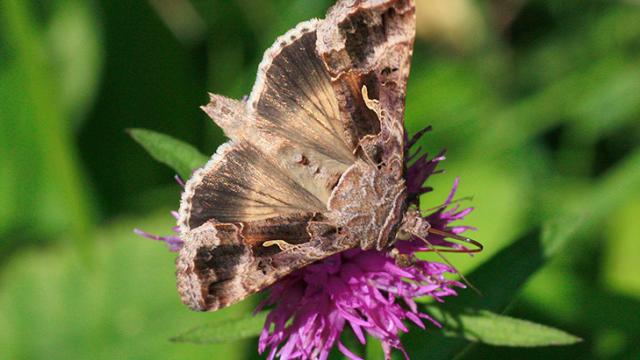The European silver Y moth (pictured above) can sense delicate shifts in turbulence as they migrate from northern Europe to the Mediterranean and back again, according to a new paper in Current Biology, enabling them to navigate their flight path effectively.
Because they’re so small, moths and other flying insects are buffeted by crosswinds and thus must constantly adjust their course. If it’s an insect that primarily flies around during the day, the sun is a dandy landmark to help them orient themselves. (Some species can detect polarised light on a cloudy day.) But moths are nocturnal creatures, so there must be another navigation mechanism at work.
“Imagine you’re in a hot air balloon, drifting with the wind at night, and you closed your eyes. And someone said, ‘Which way is the wind blowing?’ You would have no idea,” co-author Jason Chapman — who studies how animals move at England’s Rothamsted Research — told Inside Science. “You’re moving in the fluid, the air, and you’re in a sensory vacuum.”
Fortunately, turbulence is governed by the rules of fluid dynamics, and one of those is that there is less of it when you’re flying downwind. So if the moths could sense shifts in turbulence as they flew, they might be able to figure out which way the wind is blowing — and where that wind is carrying them. It’s kind of like licking your finger and holding it up to the wind. Yeah, ok, moths don’t have fingers, but Chapman and his co-authors (a team of Swiss scientists from Lund University) found evidence that silver Y moths can nevertheless sense these changes in turbulence as they fly, and adjust accordingly.
The group pored over scads of radar data tracking the movement of thousands of insects and birds through northern Europe over a period of 15 years (1999 to the presence), focusing especially on migration paths. And they used an odd quirk of physics called the Ekman spiral as their metaphorical “smoking gun”.
The Ekman spiral is an outgrowth of the Coriolis Effect. The Earth is in constant rotation on its axis, which means air currents flow counter-clockwise in the Northern hemisphere and clockwise in the Southern hemisphere. (That notion that the water in your toilet flush counter-clockwise in the north and clockwise in the South is a myth, however.) But those same currents in the Northern hemisphere shift to clockwise rotation at higher and higher altitudes. And this variable wind direction would naturally wreak havoc with migrating creatures; they would need to adjust, either through visual cues or other means.
Because turbulence can be misleading, Chapman et al. hypothesized that their moths would over-correct their flight path slightly to account for the Ekman spiral. Specifically, they would misalign every so slightly to the right when flying downwind in the Northern hemisphere, and vice versa in the Southern hemisphere. And that’s exactly what the radar data showed. (Songbirds, in contrast, didn’t seem to respond to the shifts in turbulence at all, which means they might be relying on visual cues for course correction.)
The catch: while the study provides evidence that this is how the silver Y moth navigates, the exact mechanism for how it achieves this remains mysterious. I mean, they create their own turbulence as they flap their wings during flight; somehow they can tell the difference between that and other kinds of turbulence. So what do they use as a compass?
Scientists aren’t sure, but they suspect the moths can also sense magnetic fields, an ability they would share with flies, beetles, ants, bees, and termites. A 2008 paper in the same journal found that silver Y moths only migrate on nights when the winds are favourable, and posited they must rely on a magnetic sense to make that call. (There is also a theory that moths may navigate via distant celestial lights, and this is why nearby terrestrial light sources — like lanterns or a candle flame — frequently lure the insects to their doom. They don’t sense the need for course correction until it’s too late.)
What would really nail this thing down, according to Chapman, would be replicating the experiment, this time in the Southern hemisphere. If the data analysis (using the same Ekman effect) shows the moths veering to the left, it would be a strong indication that moths really do make use of a metaphorical finger in the wind to determine direction.
[Via Inside Science News Service]
Picture: Ian Woiwod, Rothamsted Research
References: Chapman, Jason et al. (2015) “Detection of Flow Direction in High-Flying Inset and Songbird Migrants,” Current Biology 25(17): R751-R752; Carde, Ring T. (2008) “Insect Migration: Do Migrant Moths Know Where They Are Heading?” Current Biology 18(11): R472-R474.
